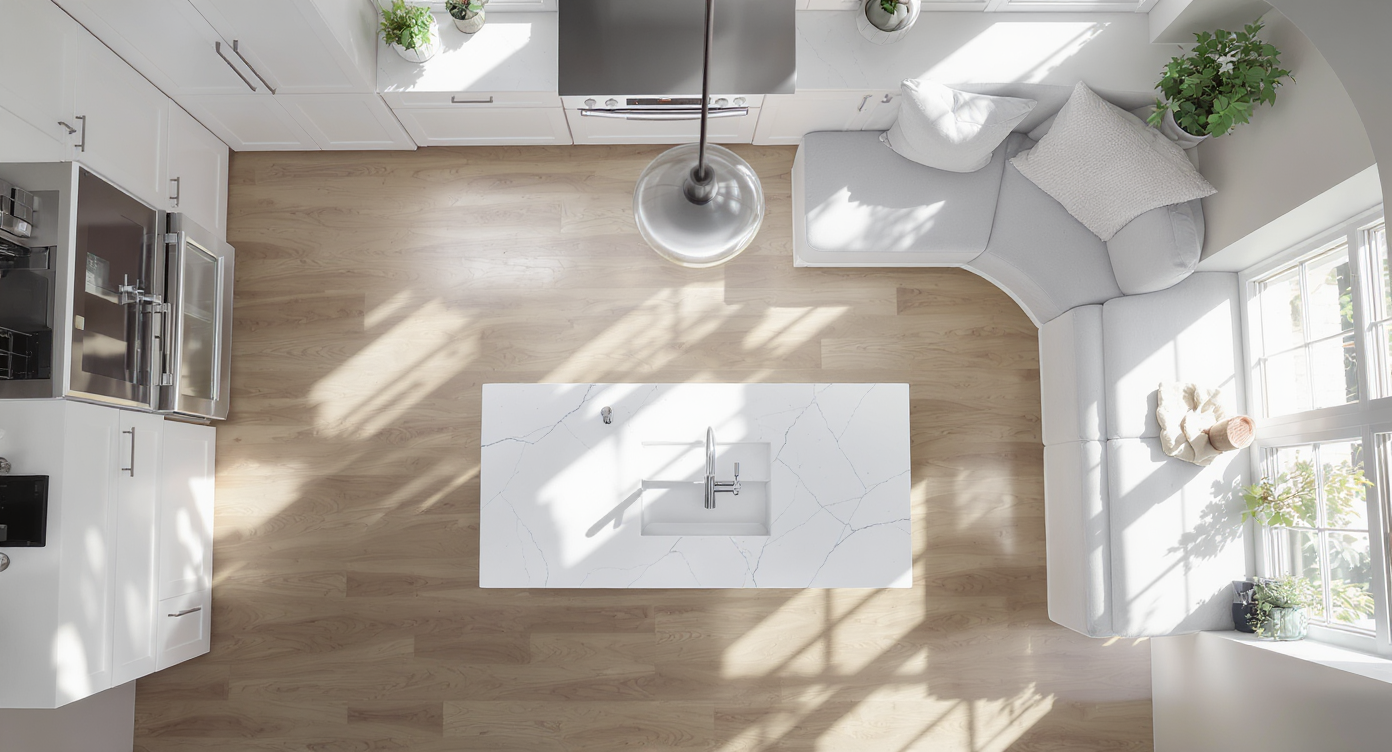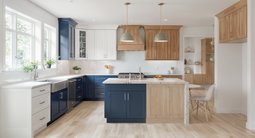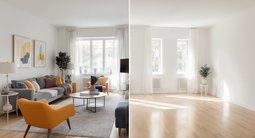TL;DR
If your small kitchen needs daily prep space, a slim kitchen island with 36–42 inches of clearance around it usually wins. If you need comfortable everyday seating or WFH space, a built-in breakfast nook with storage and an extendable table is more versatile. The best long-tail strategy: choose a counter-height table or split-level island so you get extra counter and a place to sit without crowding the room.
The small-kitchen dilemma: island vs breakfast nook

Clear floor plan illustrating kitchen island and breakfast nook options with exact clearances for small wall kitchens.
Quick take for searchers: Learn how to choose between a kitchen island and a breakfast nook in a small wall kitchen, with exact clearances, storage ideas, and hybrid options.
Small wall kitchens have a talent for forcing tough choices. You crave the practicality of a kitchen island — extra counter space, hidden storage, a landing pad for baking sheets — yet a breakfast nook promises cozy meals, better WFH ergonomics, and seats for friends. Which one fits your space and your life?
Here’s the thing: the right answer depends less on what looks cutest and more on how you move, cook, work, and host. Designers often advise measuring traffic flow first, then weighing daily routines against occasional entertaining. Below, you’ll find a clear framework, exact measurements, and a few hybrid ideas that quietly deliver both counter space and comfort.
Core strategy: decide by flow, function, and frequency
In a small kitchen, leave 36–42 inches of walkway around an island or table; if you can’t, a nook or wall-hugging solution is safer.
1) Flow — don’t block the path. Traffic lanes to the sink, stove, fridge, and the home’s main entry should stay clear. As a rule of thumb, 36 inches is the minimum, 42 inches is preferred for cooks, and 48 inches suits households with multiple helpers. If a center island pinches that path — especially near stairs or a narrow entry — pivot to a corner banquette or a peninsula.
2) Function — cook’s counter vs sitter’s comfort. If you cook or bake three-plus times a week, a work surface near the stove saves steps and sanity. A slim island can be 24–30 inches deep and 48–60 inches long, with a 10–12 inch overhang for stools. For sitters, ergonomics matter: dining seat height is ~18 inches, counter stools are ~24–26 inches, and bar stools are ~28–30 inches. If this will be your only “real” seating or a WFH spot, a breakfast nook or counter-height table is more comfortable than tall stools.
3) Frequency — design for your everyday, hack the rest. Be honest about hosting. If big gatherings happen monthly or less, prioritize daily needs — then add solutions like an extendable table or a rolling island you can park elsewhere. Experts recommend planning for the day-to-day first, then adding flexible furniture for guests.
Hybrid options that work in tight rooms:
- Counter-height table as island: Choose a 36-inch-high table with a durable top (butcher block, stone, or high-pressure laminate) and benches that tuck fully underneath. It doubles as prep space and dining.
- Split-level island: Keep the cook side at 36 inches and drop one end to 30 inches for chair-height seating. This gives counter space plus ergonomic WFH.
- L-shaped banquette with storage: Bench depth 18–20 inches, seat height 18 inches, back angle 10–15 degrees. Pair with an extendable 30-by-48 inch table that expands to seat 6–8.
- Movable cart or micro-island: A 24-by-36 inch cart with locking casters and an outlet strip can live in the nook corner yet roll out for baking marathons.
User insight: Home cooks who value day-to-day prep space rarely regret choosing the island; remote workers and hosts of game nights rave about nooks with plush backs and under-bench drawers.
Anecdote
One couple kept a petite island for years and still ate on the sofa. Swapping to a cushioned L-banquette changed everything: breakfasts together, laptops open, and suddenly the corner became the home’s heart — storage drawers packed with sheet pans were the bonus.
Common mistakes when choosing an island or breakfast nook
Most layout regrets come from ignoring clearances, underestimating seating comfort, or over-building fixed pieces in small rentals.
- Too-narrow aisles. Anything under 36 inches around an island or table becomes a shoulder-scrape lane. Solution: shrink the footprint or shift to a corner banquette.
- Stools as your only chairs. Counter or bar stools without backs get uncomfortable fast for WFH. Solution: pick stools with backs and cushions, or use a nook with standard chair-height seating.
- Dead corners. Islands can leave the far corner underutilized. Solution: add a banquette there with flip-up storage to turn dead space into baking pan heaven.
- High-maintenance upholstery. Fully upholstered benches look luxe but collect crumbs. Solution: hard bench bases with washable, zip-off cushion covers.
- Pretty table, wrong surface. Soft wood dents under rolling pins. Solution: choose a durable top or add a stone or butcher-block insert for prep.
Pro tips designers swear by
Designers often advise sizing seating at 24 inches of table edge per person and spacing island pendants 24–30 inches apart for even light.
- Overhang math that sits well. Plan a 10–12 inch overhang for counter stools so knees clear cleanly; support spans longer than 12 inches with brackets or corbels.
- Bench storage, done right. Use hinged seats with soft-close stays and 14–16 inch interior depth for bulky cookware, appliances, or linens.
- Power where you need it. If you add an island, wire an outlet on the seating side for laptops and mixers. Many codes require at least one receptacle on islands over 24 inches wide.
- Scale to the room. In compact spaces, a 30-by-48 inch table seats four daily and expands with a leaf to 72 inches for six to eight.
- Protect the view. In open plans or near stairs, keep tall pieces to the edges and choose low-backed seating to preserve sightlines into the living area.
Reflection: I’ve seen spaces transform when the “everyday first” lens is applied — suddenly the right answer becomes obvious, and cluttered corners start pulling their weight.
Real rooms, real trade-offs
Quick stories help pressure-test your choice against daily life so you don’t overbuy for rare occasions.
- The avid baker. A slim 24-by-60 inch island with drawers and a quartz top replaced a wobbly table. With 42-inch aisles, sheet pans finally had a landing zone, and weekend prep became a joy.
- The remote worker. A corner L-banquette with a 36-inch-high counter table delivered chair-height seating plus a firm work surface. A small task lamp and an under-bench outlet turned it into a tidy WFH hub.
- The entertainer. A cozy nook with a 30-by-48 inch extendable table seats four daily and eight on game night. For big dinners, a rolling cart parks by the range and adds another 6 square feet of counter.
- The renter. A foldable, counter-height table and two nesting benches made moving easy. On baking days, a marble slab stores under the bench and drops onto the table for pastry work.
Visualization Scenario
Picture this: morning light on a tailored banquette, a counter-height table pulled close, laptop plugged into a discreet outlet beneath the bench. At lunch, the leaf drops in and two friends slide into the corner seat. That night, you roll in a slim island cart for meal prep, park it by the range, and plate dishes on the expanded table. The room breathes, the path stays clear, and every square inch earns its keep.
Want to preview both versions before you buy a single stool? Try photoreal layouts with ReimagineHome — upload a room photo, test a slim island, then flip to a storage banquette with extendable table, and compare side by side.
FAQ
How much space do I need for a kitchen island in a small kitchen?
Allow 36–42 inches of clearance on all sides of a kitchen island; islands smaller than 24 by 48 inches often feel cramped and aren’t worth the squeeze.
Should I choose a breakfast nook if I WFH in the kitchen?
Yes if comfort is key — chair-height seating at 30-inch table height supports longer sessions better than counter or bar stools.
What’s the best way to host 6–8 in a small kitchen nook?
Use an extendable 30-by-48 inch table that expands to 72 inches and pair it with an L-banquette so chairs only occupy one side.
Can a breakfast nook double as prep space?
Yes — specify a durable top like quartz, stone, butcher block, or add a removable pastry slab; aim for a counter-height table at 36 inches for comfortable prep.
Is a kitchen island or a banquette better for resale?
Islands generally boost resale in cook-centric markets, while a well-built banquette shines in small, urban homes where flexible seating is prized.
So — island or breakfast nook?
If you cook often and can keep 36–42 inches clear around it, a modest island is the most practical upgrade for a wall kitchen. If comfort seating or WFH is non-negotiable, a breakfast nook with storage and an extendable table will serve you more hours of the week. The smart compromise is a counter-height or split-level solution that looks like dining yet works like a workstation. Want to see both ideas in your actual room before committing? Upload a photo to ReimagineHome and iterate layouts, finishes, and seating until the flow — and your life — clicks.
.svg)

.svg)
.jpg)












.png)